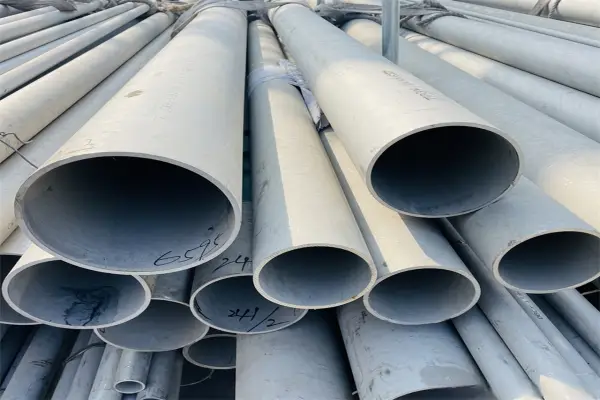Generally speaking, stainless steel is steel that is not easy to rust. In fact, some stainless steels are both rust-proof and acid-resistant (corrosion-resistant). The rust-proof and corrosion-resistant properties of stainless steel are due to the formation of a chromium-rich oxide film (passivation film) on its surface. This film isolates the metal from the external medium, preventing the metal from being further corroded, and has the ability to self-repair. If it is damaged, the chromium in the steel will regenerate a passivation film with the oxygen in the medium and continue to play a protective role.
This rust-proof and corrosion-resistant property is relative. Experiments have shown that the corrosion resistance of steel in weak media such as the atmosphere and water and in oxidizing media such as nitric acid increases with the increase of the chromium content in the steel. When the chromium content reaches a certain percentage, the corrosion resistance of the steel changes suddenly, that is, from easy to rust to not easy to rust, from not corrosion-resistant to corrosion-resistant. The rust-proof property of stainless steel is also related to the use environment. Different environments require stainless steel with different chromium contents. The chromium content is the fundamental factor that determines the performance of stainless steel. It is reported that the standards of Europe, America and other countries stipulate that the minimum chromium content cannot be less than 10.5%, Japan stipulates 11%, and my country is 12%.Both
316 stainless steeland 304 stainless steel may rust.
How to prevent 304 stainless steel from rusting?
Although stainless steel is one of the most common metals, its corrosion and rust resistance are popular among the public, but stainless steel will also rust under special circumstances. If you want to use stainless steel for a longer time, that is, to prevent 304 stainless steel from rusting, you can take the following measures:
Keep the surface clean: Clean the stainless steel surface regularly to remove dirt and dust. You can use a mild detergent with a soft cloth to wipe it. Avoid using cleaners containing chlorine or acidic ingredients, as they may damage stainless steel.
Avoid collisions and scratches: Try to avoid scratching the stainless steel surface with hard or sharp objects to avoid scratches and damage. In addition, be careful to avoid heavy objects colliding with stainless steel objects to avoid dents or deformation.
Prevent salt spray and humid environments: If stainless steel is in salt spray or humid environments, especially at the seaside or in humid climates, additional protective measures should be taken. Passivators, anti-rust coatings or protective films can be used to protect the stainless steel surface, and regular inspections and maintenance should be carried out.
Regular maintenance inspection: Regularly check whether there are any problems such as damage, corrosion or fatigue cracks on the surface of stainless steel. If any abnormality is found, repair or replace the damaged parts in time to ensure the normal use of stainless steel and extend its service life.
Use the right stainless steel grade: Choose the right stainless steel grade according to the specific use environment and needs. Different grades of stainless steel have different corrosion resistance. Choosing the right material can improve the corrosion resistance of stainless steel.
What should we do when 304 stainless steel rusts?
Stainless steel 304 is a stainless steel material with good corrosion resistance, but it may still rust under special circumstances. So, what methods should be taken to remove the rust of 304 stainless steel?
First of all, passivation treatment is a common method. Passivation treatment improves its corrosion resistance by forming a dense chromium oxide film on the surface of stainless steel. Acidic passivators, such as nitric acid, sulfuric acid, etc., can be applied to rusted parts to remove rust and form a new protective layer.
Secondly, mechanical treatment is also an effective method. Grinding and polishing equipment can be used in combination with appropriate abrasives to carefully treat the rusted parts. This method can remove the oxide on the surface of stainless steel and restore its original finish and appearance.
In addition, chemical dissolution can be used to remove rust from 304 stainless steel. You can choose an appropriate dissolving agent, such as an acid solution, a corrosion inhibitor, etc., apply it to the rusted part, soak and dissolve it for a period of time until the rust is completely removed.
Proper maintenance and daily cleaning are also the key to preventing and removing rust from 304 stainless steel. Keep the surface of stainless steel clean, wipe it dry in time, and avoid long-term contact with moisture and harmful substances. Regular cleaning with a neutral detergent and wiping with a clean soft cloth will help prevent rust.
In short, passivation treatment, mechanical treatment, chemical dissolution and other methods can be used to remove rust from 304 stainless steel. It is important to choose the right method before treatment and take appropriate protective measures according to the situation to ensure the integrity and lasting beauty of the stainless steel surface. Regular maintenance and cleaning are also effective means to prevent rust and should be taken seriously and implemented.






 English
English Español
Español بالعربية
بالعربية











 Phone :
Phone :  Whatsapp :
Whatsapp :  Email :
Email : 


